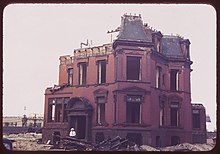Prairie Avenue
This is especially true of the period of recovery from the Great Chicago Fire of 1871 when many of the most important families in the city moved to the street.
The redevelopment extended the street so that it has prominent buildings bordering Grant Park with Prairie Avenue addresses.
[1] Many of the leading architects of the day, such as Richard Morris Hunt, Henry Hobson Richardson and Daniel Burnham designed mansions on the street.
Early 21st century deindustrialisation, urban congestion, and historic preservation have brought the return of trendy buildings, and restored as well as renovated structures.
Thus, the business district began to supplant the elegant residences along Michigan and Wabash Avenues south of Jackson Boulevard.
[11] Shortly after the Civil War, the city's wealthy residents settled on Prairie Avenue due to its proximity to the Loop less than a mile away and the fact that traveling there did not involve crossing the Chicago River.
[13] The post-fire South Side of Chicago grew rapidly as all economic classes left the city's center.
[14] In 1886, the urban elite, including George Pullman, Marshall Field, Philip Armour and John B. Sherman all owned family homes in this area that created an opulent Prairie Avenue streetscape reminiscent of European city streets;[13] as such, it was widely regarded as the city's most fashionable neighborhood.
[15] Additional grand homes (including many Queen Anne style architecture in the United States and Richardsonian Romanesque) were located on Prairie between 26th and 30th Streets starting in the mid-1880s.
[5] However, as the start of the 20th century came, industry's pervasive reach, increased railroad soot, and an encroaching vice district, caused the area to become less desirable, and the social elite vacated the region for quieter neighborhoods such as Kenwood, the Gold Coast and more commonly the suburban North Shore.
[6] Starting in the late 1990s, the downtown housing market flourished in Chicago and the resulting boom that has transformed many neighborhoods revived Prairie Avenue, causing most of the factories to be demolished or converted to loft condominiums.
[17] 1801 South Prairie resident, William Wallace Kimball, employed about 1500 people around the start of the 20th century in his organ and piano manufacturing company.
[24] Today, Prairie Avenue has buildings indexed in the Chicago Historic Resources Survey in the Near South Side, Douglas, Grand Boulevard, Washington Park and Chatham community areas.
[25] Among the properties listed is a simple two-flat used by Al Capone in the 1920s at 7244 South Prairie in Greater Grand Crossing.
Donnelley & Sons Company and now jointly serve as the national headquarters for the United States Soccer Federation (USSF), which leased them from 1991 until 1998 when it purchased them from the Chicago Architectural Foundation.
[5] The Kimball house, which has been the product of a $1 million renovation in the 1990s by the USSF was featured in Richard Gere's Primal Fear as well as several television shows.
[5] Al Capone and his family lived in the two-story red brick duplex at 7244 South Prairie Avenue from 1923, which is shortly after he moved to Chicago, until 1931, when he was sent off to prison for income tax fraud.
In 1988, the privately owned house was nominated for the National Register of Historic Places by historians as the home of one of Chicago's most famous citizens.
[30] The nomination was withdrawn after local politicians and members of Italian-American groups sharply argued that it would appear to validate the life of a murderer and hoodlum.
The house retains the security bars on the basement windows and the brick garage out back, which the Capone built for his bullet-proof Cadillac limousine.
The conflict, which was not settled before wreckers had knocked a hole in a corner of the building and which included protests and a petition to the Illinois Supreme Court, was described on the front page of The New York Times.
[31] Preservationists, including the Landmarks Preservation Council of Illinois and the National Trust for Historic Preservation, eventually dropped their appeals once the Metropolitan Pier and Exposition Authority committed to incorporating the original facade of the building into the exterior of the parking garage at an additional cost of $2.5 million to the project.



